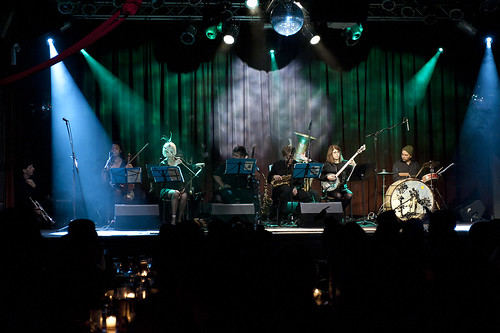
Ghost Train Orchestra.
Christmas carols generally define the sounds of winter holidays, and patriotic tunes create a soundtrack to Fourth of July celebrations. As far as setting the mood for Halloween eve, the Philadelphia Museum of Art designated the jazz stylings of Brian Carpenter’s Ghost Train Orchestra. The band, led by Carpenter on trumpet, will take the stage at The Philadelphia Museum of Art’s “Art After 5” Halloween dance party Friday, Oct. 28.
The nine-piece orchestra, which includes Temple graduate student Andy Laster on saxophone, is the product of Brian Carpenter’s explorations and innovations in jazz. Taking cues from a distinct period in the genre’s history on their first album, “Hothouse Stomp” re-envisioned the work of mid-1920s jazz masters through arrangements by Carpenter. Though Carpenter is based in Massachusetts, the group’s eight other members live in New York City. It’s there that Carpenter said the orchestra’s popularity has quickly gained pace, citing a performance at the Museum of Modern Art, and the band’s shows at different venues that cater to enthusiast’s in the city’s “Lindy Hop scene.” They played their first show in Philadelphia at Johnny Brenda’s this past August.
Ghost Train’s upcoming album, set for release next year, moves slightly forward in the history of jazz to the mid-to-late 1930s with “chamber jazz” arrangements.
The album will showcase the music of the era by bandleaders John Kirby, Alec Wilder, Raymond Scott and Reginald Foresythe. Ghost Train exists alongside the Americana band Beat Circus, another musical undertaking by Carpenter. Carpenter spoke with The Temple News about feeding off past jazz masters and their music, the orchestra’s evolving nature and returning to Philadelphia for the Halloween show.
The Temple News: What role do you play as the leader of a nine- piece band?
Brian Carpenter: Most of the work is transcribing and arranging. I’m downloading from a 78 player, a USB plugs into it and I download it into an MP3 to listen to it and extract the harmonies. It drives my wife crazy when I’m doing this, playing a phrase over 10 times, repeating it over and over. But it’s kind of fun, it’s like a puzzle: How do you put your own stamp on it with the personalities in the band?
TTN: How would you describe your style? Why’d you decide to highlight this style of jazz on your first album?
BC: I just like it because it’s so bluesy, it’s sort of sophisticated but not at the same time. It retains the ‘bluesiness’ of original New Orleans jazz and that’s why I like it. It fits in between big band jazz, from 1927 to 1932, and early New Orleans jazz from the late 1910s and early 1920s. When you get past 1940 there’s a heavier swing, a swing into the eighth notes that’s heavier. I played that a lot in high school but I’m not interested [in that now]. [With this] there’s a lighter swing but it’s still so in the pocket –– that’s what separates it from a lot of other jazz bands, you just don’t hear that with any other band.
TTN: How do you work with the music of other artists? Do you generally try to stay true to the original?
BC: It’s important in anything to take it a step further and really bring your own personality into it –– what we’re experiencing now. Otherwise, why do we create something that’s already been done? That’s something we try to do on this [second] record, take it further and make it more futuristic, more far gone. I’m not interested in doing a recreation, but something different that people can relate to, where the voice is something they can relate to. The more things you can add like that the better. I’m a big history buff, I like other worlds and learning from them is entertaining and fun, hopefully for listeners, too. They can read the liner notes and find out about these composers. That’s how I [initially] found out about them, or someone played me a 78 and I said ‘wow.’
TTN: Why does your music work for the Philadelphia Museum of Art’s Halloween event?
BC: I’m not exactly sure why it’s appropriate, but it does have a voodoo jazz quality going on. It’s pretty unique to this band –– no other band plays this material, or plays it like we do. There’s some creepiness to it definitely, we do get asked to play these Halloween shows and I think it’s cool. We try to make it creepy and pick the right repertoire.
Kara Savidge can be reached at kara.savidge@temple.edu.


Be the first to comment